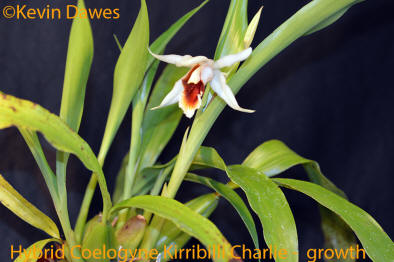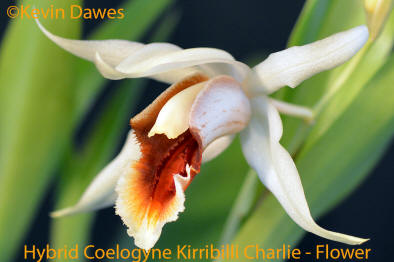Wow! How exciting Coelogyne hybridising is going to be in the next generation! Over the last ten years a number of breeders have broken all records in developing new primary hybrids with spectacular results. They have broken into a totally new orchid plateau and have opened up new and spectacular possibilities for the future of Coelogynes. This new hybrid is moving up one level more in complexity from a primary hybrid to a secondary hybrid involving a combination of genes from three parents. This one is not the first secondary hybrid example but more on-going proof of my theory that Coelogynes can be hybridised easily and have amazing potential.
The more genes that get involved in a hybrid the more chances of variations and surprises. When desirable characteristics come out, there becomes a need to "line breed" to try and make these characters "fixed" so that they will predictably turn up in the next and every subsequent generation. This involves breeding brother and sister, parents and off-spring and close family members together to continually emphasise the particular trait the breeder is aiming to set as a dominant feature.
Line breeding has gone through stages of absolute scorn at times in history. Some animal breeders thought that it promoted and reinforced the weaknesses in a breed but many famous UK and European sheep breeds rose to their great fame because their stud masters knew about line breeding. They scorned the many breeders who ended up with a fathomless pit of genes - '... marrying anybody's daughter to nobody's son'. Compare the state of freshness of Coelogyne breeding to this situation with Cymbidiums, Cattleyas, Paphs, etc, etc.
Coelogyne Kirribilli's pod parent, hybrid Coelogyne Amber, was bred by one of the new generation of breeders, David Banks, of Sydney Australia. He used a cross between Coelogyne speciosa and Coelogyne ovalis. Both of these are popular, hardy orchids with very dark brown colouring, especially on the lip of the flower.
I choose Coelogyne mooreana 'Brockhurst" to be the pollen parent for Coelogyne Amber so as to introduce more white colouring into the new flower and to work towards a more upright spike and presentation and a more open flower.
The influence of Coelogyne mooreana in this mix has been spectacular
and far greater than anticipated. The new hybrid has produced very upright
spikes with really well-presented open-faced flowers that are a very
impressive 10cm wide. The most impressive trait has been the influence of
Coelogyne mooreana's colouring. It has been far more dominant than the
colouring from Coelogynes speciosa and ovalis coming from
Coelogyne Amber. The sepals and petals are a clean, crisp, creamy white,
while the distinctive clear orange of Coelogyne mooreana has exerted a
powerful influence on the dark lip of the pod parent. This has produced a
most attractive, rich burnt orange over a large area of the throat and
fading out to a rich orange/lemon almost right at the tip.
Interestingly, the clean, distinctive keel pattern from Coelogyne ovalis has carried through with little sign of the fimbriated keels of either Coelogyne speciosa or mooreana. Surprisingly too, hints of the brown splashes on the outside of the lip have passed on from Coelogyne ovalis.
The narrow petals, coming from the Coelogyne speciosa and Coelogyne ovalis parentage, have only slightly widened in the new off-spring indicating that the wide petal trait of Coelogyne mooreana may not be a dominant trait.
If the narrow petals and cleanly defined keels are ignored, there is a superficial resemblance to the beautiful hybrid Coelogyne Memoria Wilhelm Micholitz. These two hybrids could end up in competition with each other.
Coelogyne Kirribilli Charlie has a very compact growth habit (i.e. no rambling habits from Coelogyne ovalis). The psuedobulbs are very close, slightly elongated, very slightly compressed and noticeably quadrangular. The new spike is produced from the top of a developing shoots (i.e. synanthous). The bifoliate leaves have a strong mid-rib but very subdued lateral veins.
For those interested in the timing sequences of this hybrid, it was pollinated on 28.04.2011. It was flasked 12 months later on 06.04.2012 and deflasked on 09.10.2013. It first flowered on the 18.01.2016.
Negatives: As this is the first flower more time is required to observe faults. The first flower only lasted two weeks. A longer lasting flower is always a desirable trait.
Rating: ♦♦♦♦
Registration: Registration with the RHS as Coelogyne Kirribilli Charlie was recorded in January 2016. It has been named after my grandson, Charlie. May they both bloom forever.
Varieties: None known.
Hybrids: None registered
| < Coel Kirribilli Carmel | Coel Kirribilli Colin > |

